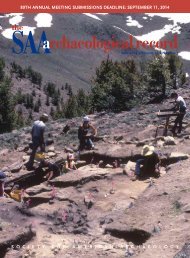SAA
SAA_Record_Nov2015
SAA_Record_Nov2015
You also want an ePaper? Increase the reach of your titles
YUMPU automatically turns print PDFs into web optimized ePapers that Google loves.
PROS AND CONS OF CONSULTING COLLECTORS<br />
not have passed them off as originals in an artifact sale. But<br />
that was not Moore’s goal; it was to sell books. As a local historian,<br />
he was quite successful. Today, many expert flint<br />
knappers have the skill to produce accurate replicas. I wonder<br />
how many of the Paleoindian artifacts now in collectors’<br />
homes and galleries are truly authentic and collected from<br />
the sites they are said to have come from. I also wonder how<br />
much misinformation from collectors has found its way into<br />
the published record.<br />
Soon after these events in the Rogue Valley, I moved to the<br />
University of Nevada and continued to see the effects of artifact<br />
collecting on public land. In the early 2000s, my students<br />
and I conducted archaeological surveys in upland valleys<br />
near Wells and Ely. Despite finding many archaeological<br />
sites, few seemed to be intact, having disproportionately few<br />
finished tools. At one dune site far from the nearest maintained<br />
road, we spent an entire day walking transects and<br />
flagging surface finds for mapping and field analysis. The<br />
next day, we returned to finish the job, only to find that all of<br />
the bifacial points had been taken. All that remained were<br />
flakes, a few broken tools, our flags, and ATV tracks crisscrossing<br />
the dune.<br />
Figure 1. Jack Harelson at Elephant Mountain Cave, standing in his<br />
looter’s pit and pointing at the original, pre-looted surface of the cave<br />
(photo taken by Harelson’s wife; provided to the author by Pat Barker).<br />
see whether it retained any research potential, we were sorely<br />
disappointed to find that Harelson had practically demolished<br />
it.<br />
A different kind of experience with a collector also occurred<br />
during my days in southern Oregon. In the 1970s, professional<br />
artifact collector Earl Moore made a brilliant<br />
discovery— a cache of Clovis points and other amazing artifacts<br />
from an undisclosed location somewhere along the<br />
divide of the Rogue and Umpqua Rivers. The “Divide Cache”<br />
became a featured part of Moore’s book Silent Arrows (1977),<br />
but for years it was the object of controversy because Moore’s<br />
vague provenience descriptions suggested that he had taken<br />
the artifacts from public land. After years of pleading by the<br />
Rogue River National Forest archaeologist, Moore’s heirs<br />
returned the artifacts, and the pieces became available for<br />
study. Jeff LaLande and I were astonished to find that Moore<br />
had created the Clovis points himself, taking some late<br />
Archaic ceremonial bifaces and poorly fluting them by<br />
reshaping their bases and grinding their surfaces to create<br />
flutes. This occurred 40 years ago, and even then he could<br />
At about this time, Kelly Graf, Bryan Hockett, David Rhode,<br />
and I began working at Bonneville Estates Rockshelter near<br />
West Wendover, Nevada (Rhode et al. 2005). It, too, had fallen<br />
prey to looting shortly before our project began. We estimated<br />
that 25 percent of the shelter’s greater than 1-m-deep<br />
cultural deposits were illegally dug by artifact collectors. In<br />
the jagged profiles remaining, we could see a sample of what<br />
they took: not just bifacial points dating from 8,000 years<br />
ago to the protohistoric period, but a variety of features,<br />
including perishable artifacts such as cordage, baskets, bone<br />
awls and needles, and carved wooden pegs used as snares.<br />
Despite the BLM’s best efforts, the looted artifacts have not<br />
been retrieved and likely never will be.<br />
Why are these federally owned archaeological sites being targeted?<br />
The answer is obvious: for collecting. Countless artifacts<br />
from Brush Creek, Elephant Mountain Cave, Bonneville<br />
Estates Rockshelter, and many other sites on federal land<br />
have likely found their way to the collector market. If they<br />
ever become available to professionals for study, their original<br />
provenance will undoubtedly remain concealed, because of<br />
their illegal origin. Aren’t we, by working with the owners of<br />
these potentially stolen artifacts, legitimizing their theft?<br />
Since leaving Nevada and joining the Center for the Study of<br />
the First Americans at Texas A&M University, I have seen<br />
another worrisome aspect of collecting: commercialization<br />
of the archaeological record through professional display<br />
30 The <strong>SAA</strong> Archaeological Record • November 2015




